Pierre Poilievre may have the advantage, but his popularity is softening: New Abacus polling on Canadian politics.
May 25, 2022
Our latest nationwide public opinion survey shows little change on several of the variables that we track, but we do see evidence that Pierre Poilievre has lost some popularity over the last few weeks.
VOTE INTENTION & VOTER POOLS
Since 2022 began, the Liberals have been tracking between 30% and 33%, and so has the Conservative Party. Our most recent vote intention measures find the Conservatives and Liberals tied with 31%, the NDP at 19%, and the BQ at 8% (32% in Quebec).
Compared to the results of the last election, the Conservatives find themselves down three points, the Greens up 3 (to 5%) and no other party has seen a statistically significant shift.

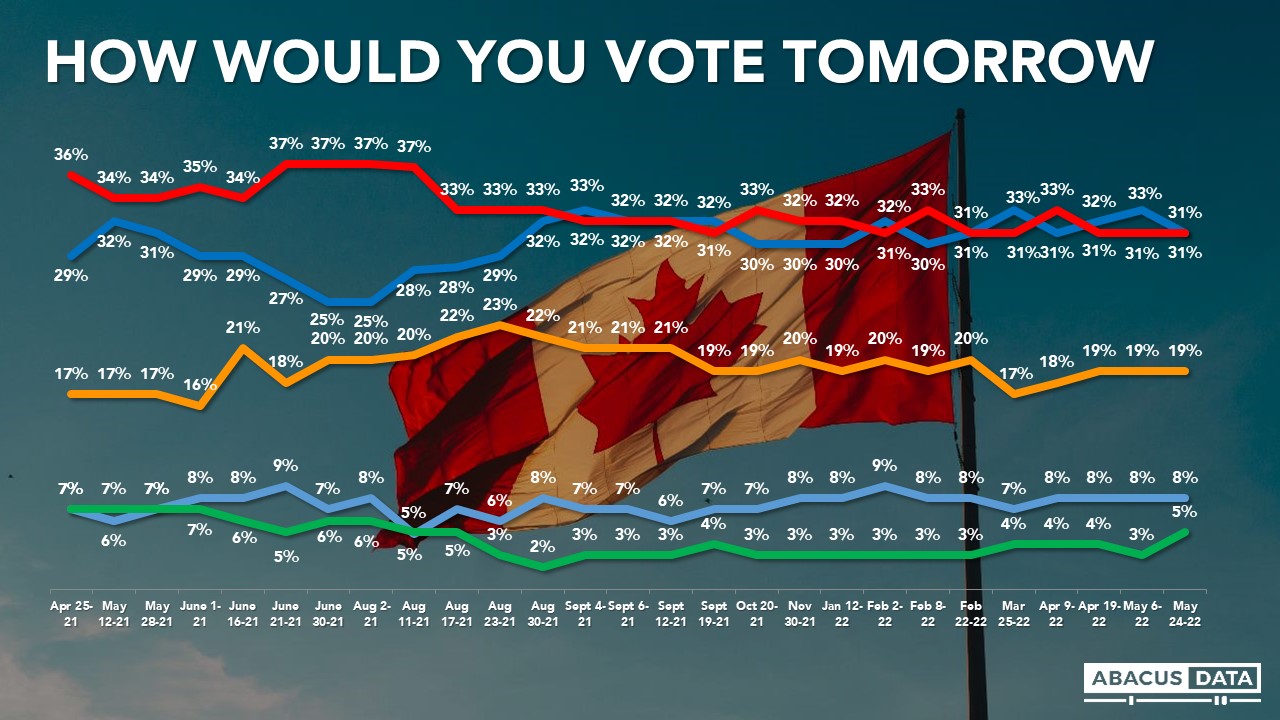
Regional patterns continue to show a three-way split in BC, large advantages for the Conservatives on the Prairies, a modest Liberal lead in Ontario, a tight battle between Liberals and BQ in Quebec and a wide Liberal lead in Atlantic Canada.
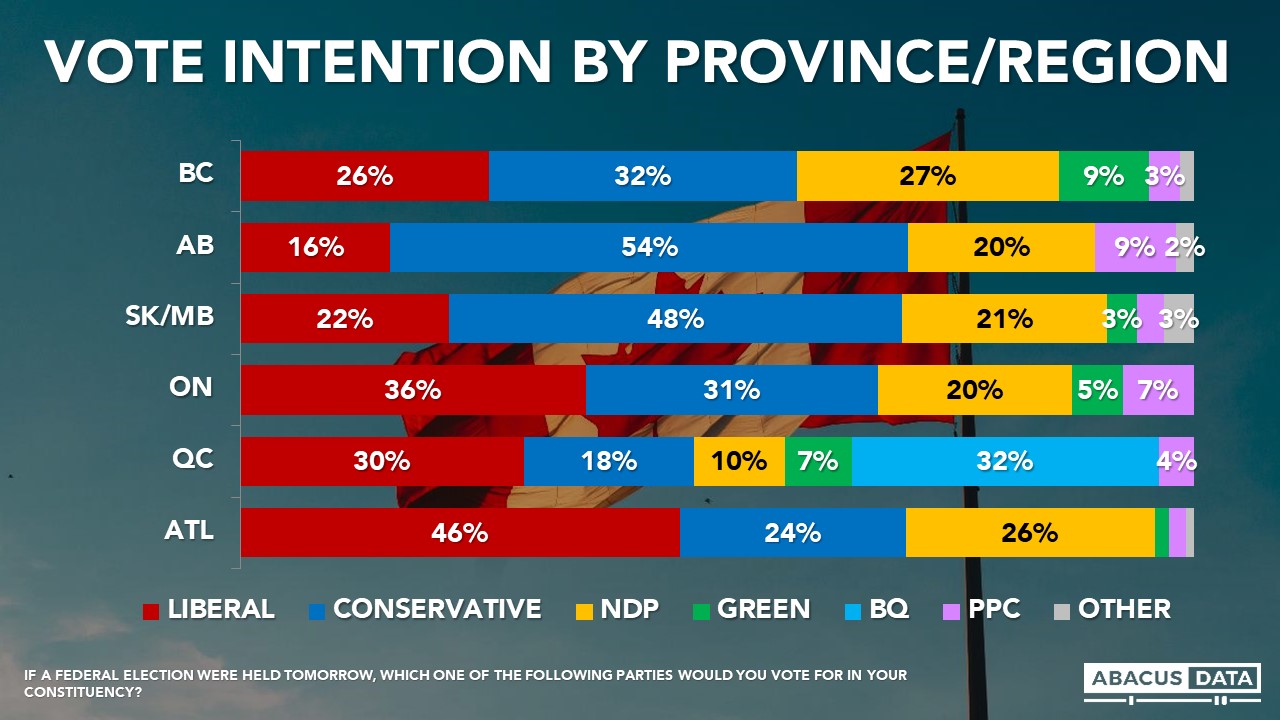
Accessible voter pools show that 52% would consider voting Liberal, 46% NDP and 41% Conservative. The CPC pool is 5 points smaller than we found five weeks ago.
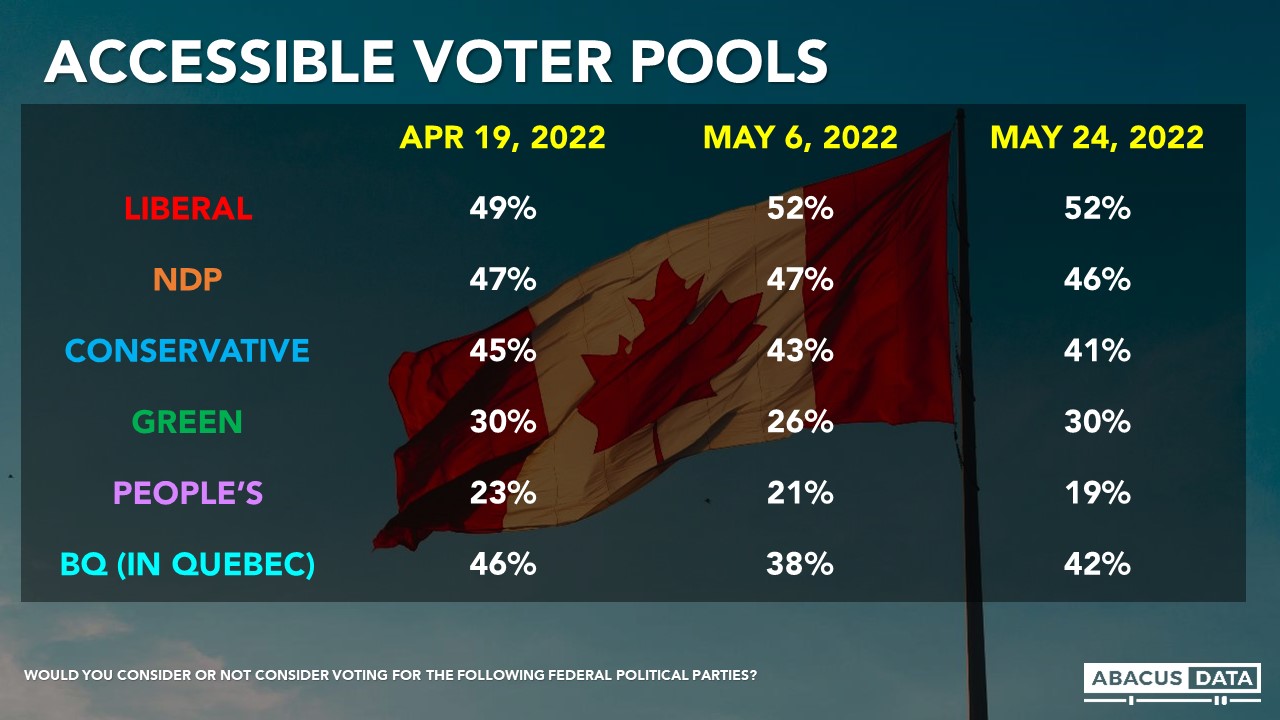
PUBLIC MOOD
Today 38% of Canadians think the country is headed in the right direction, while 45% think it’s off on the wrong track. Views about the state of the world remain much more negative.
Approval of the federal government is fairly steady with 40% approving and 43% disapproving.
Public opinion about the federal party leaders also shows little change with Trudeau having a net score of -8 (36% positive – 44% negative). We have seen no movement for Jagmeet Singh, he remains the most popular national party leader with a net score of +14. Interim Conservative leader Candice Bergen is at a -11 net score.

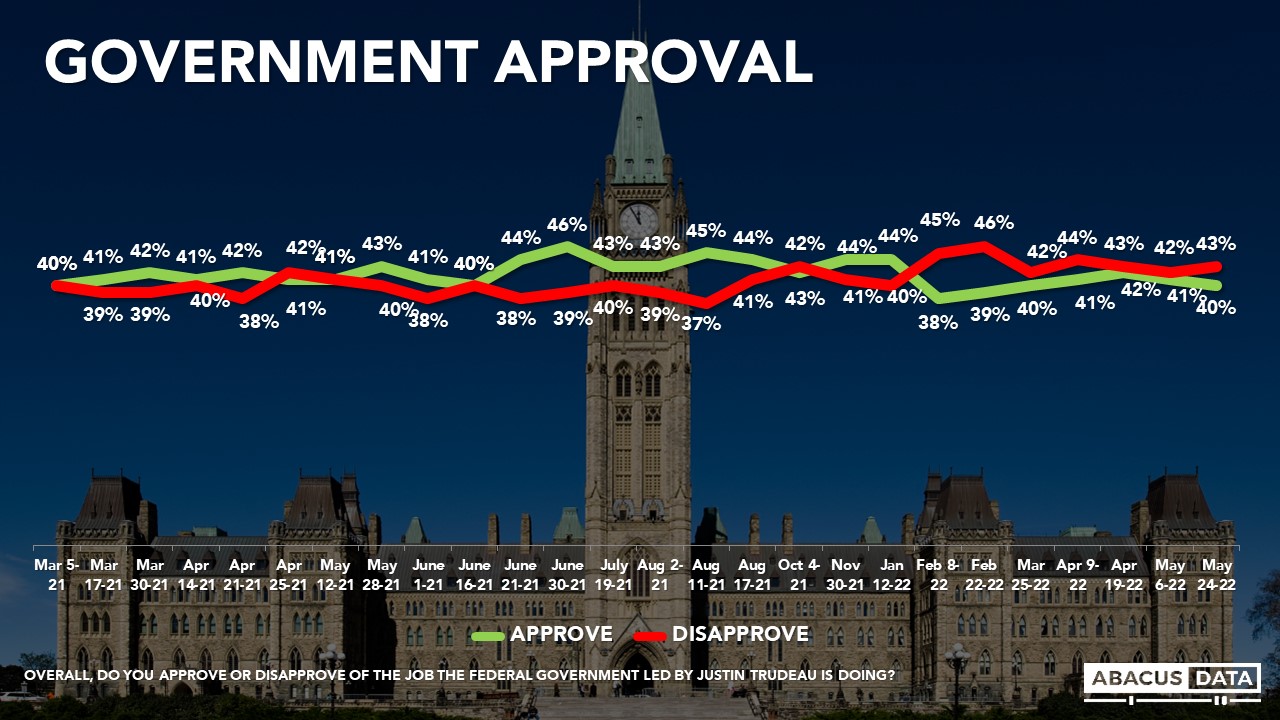
CONSERVATIVE LEADERSHIP
Compared to our results in early-May, Conservative leadership candidate Pierre Poilievre has seen his positives decline by 4-points and his negatives grow by 4-points, meaning he went from a net score of +1 to a -7 over that period. Among current Conservative voters, the shift has been more noticeable: Poilievre has gone from a +43 to a +28. With his negatives rising 7-points. He remains the most liked candidate among Conservative voters. During the same period, Mr. Charest’s image has held steady among all Canadians but his negatives are up 4-points among CPC supporters as his net score shifted from +5 to +1.

The other candidates are less well known, and we see little shift in views except for Mr. Brown who has seen his positives among CPC supporters drop 6-points.
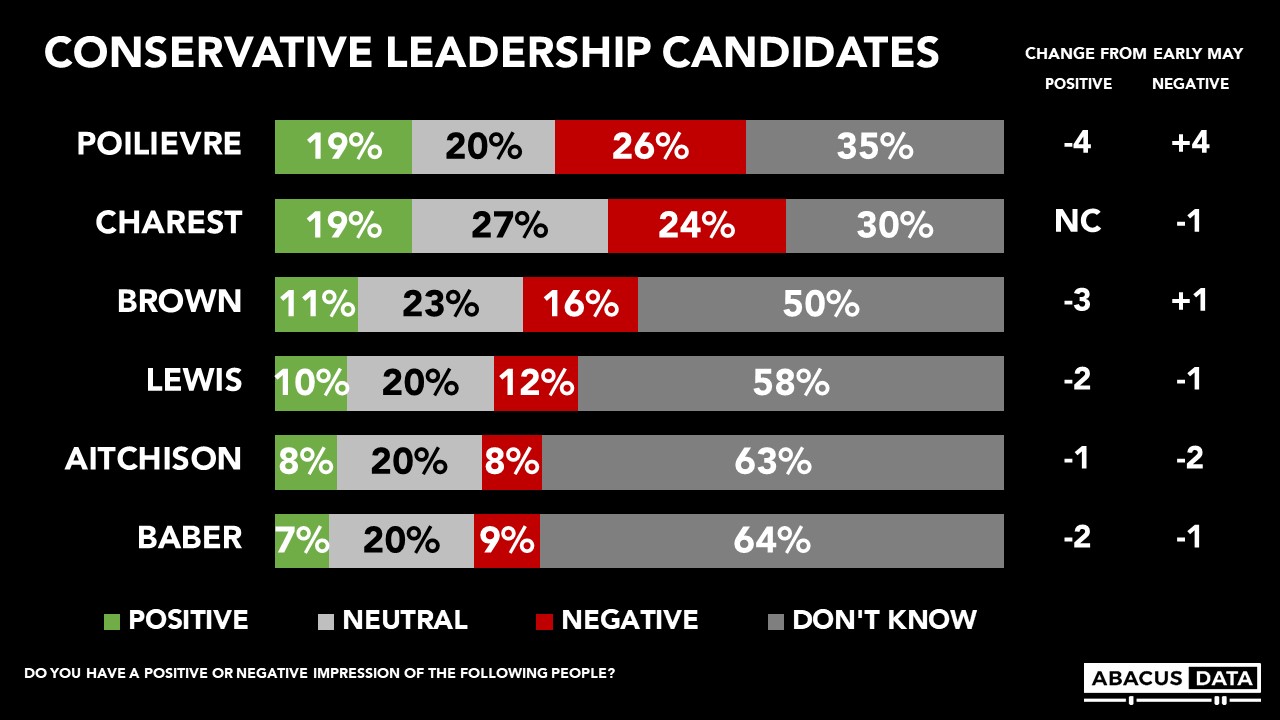

Among all Canadians, when asked which candidate best reflects their values and ideas, Jean Charest comes out on top with 32% followed by Pierre Poilievre at 26% and Patrick Brown at 17%. Charest had a 3-point advantage on this question in earlier this month, which has widened to a 6- point advantage.
Among current and accessible Conservative voters, Poilievre continues to lead by a wide margin but his lead over Charest has decreased going from 28-points in early May to 21-points today among CPC supporters and from 14-points to 9-points among those open to voting CPC.
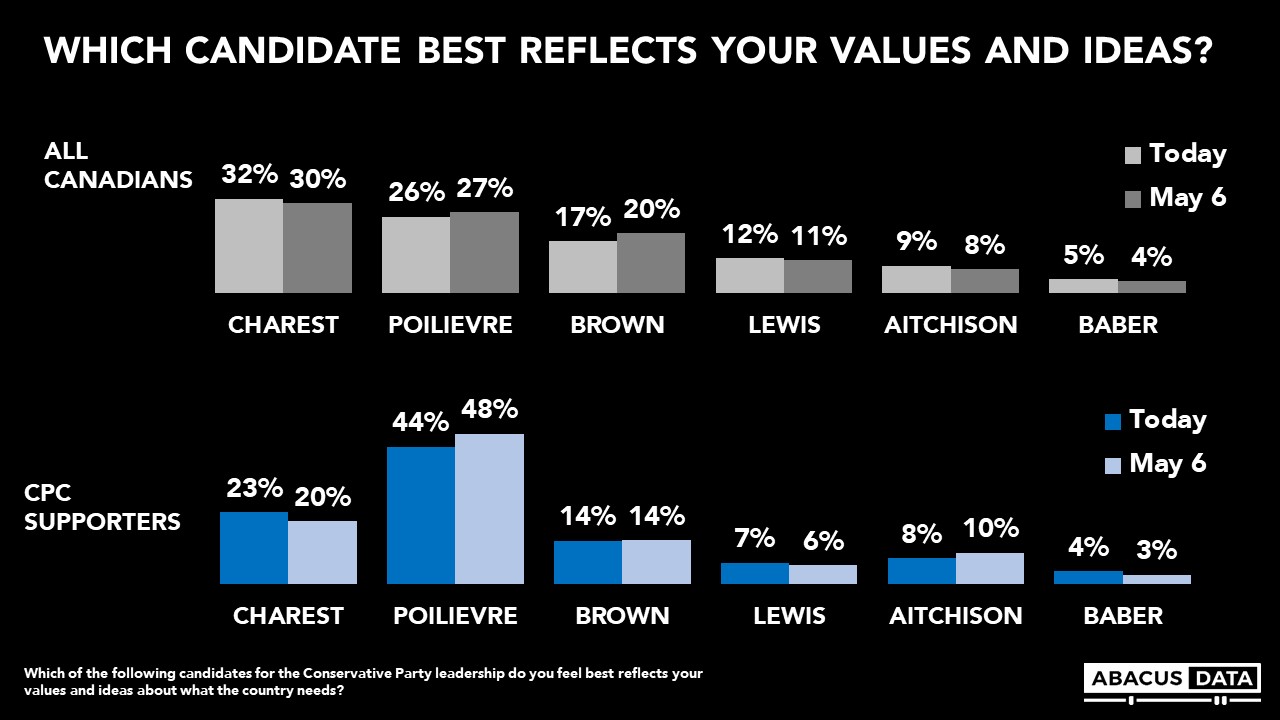
UPSHOT

According to Bruce Anderson: “Interest rates are rising and inflation is relatively high, but there is no sign that these factors are weakening the standing of the Trudeau Liberals – current findings would result in another victory, potentially a larger one, if an election were held today.
The findings of the Conservative leadership race are interesting in two respects.
First, for the party to see its accessible voter pool shrink as the race gains visibility is not a good sign, in an ideal world the opposite would be happening. Over the last month observers are finding the party less – rather than more – appealing.
Second, the downward shift in feelings about Mr. Poilievre may serve as a warning to him and his campaign – his policy positions and style clearly have stopping power, and he continues to hold a wide popularity lead among Conservative voters, but he is seeing in these results that his approach has the potential to create negative reactions too. Meanwhile, Jean Charest seems established as the second most popular candidate, and the one with the greatest potential to win votes from the Liberal Party in a general election. Time will tell whether this becomes a more central question for those choosing the next Conservative leader

According to David Coletto: “Although the federal political landscape appears to be quite static, we are seeing some noteworthy shifts in views about some of the candidates running to become the next leader of the Conservative Party. For the first time since we started tracking impressions of the candidates, Mr. Poilievre is showing that he is not immune to criticism and his image can be penetrated. Since earlier this month, his negatives with the general public are up 4-points while negative impressions among Conservative Party supporters are up 7. He is still by far the most liked candidate in the race, and more Conservative supporters think his values best reflect their own, but more than a week of fairly relentless critical commentary about his positions and outlook has taken its toll.
For Mr. Charest and the other candidates, this presents an opportunity and perhaps some hope that Mr. Poilievre is not unbeatable nor impenetrable to criticism. But Mr. Charest’s liabilities remain apparent. His image has not improved over the same time frame and among Conservative supporters, he remains the least popular (in terms of those with a negative impression of him).
For the Conservative Party more generally, a drop in its accessible voter pool and vote share should be concerning during the leadership race. This should be a time when the tent expands and more people pay attention to the party – not a time when it’s audience narrows.”
METHODOLOGY
The survey was conducted with 1,500 Canadian adults from May 20 to 24, 2022. A random sample of panelists were invited to complete the survey from a set of partner panels based on the Lucid exchange platform. These partners are typically double opt-in survey panels, blended to manage out potential skews in the data from a single source.
The margin of error for a comparable probability-based random sample of the same size is +/- 2.6% 19 times out of 20.
The data were weighted according to census data to ensure that the sample matched Canada’s population according to age, gender, educational attainment, and region. Totals may not add up to 100 due to rounding.
This survey was paid for by Abacus Data Inc.
Abacus Data follows the CRIC Public Opinion Research Standards and Disclosure Requirements that can be found here: https://canadianresearchinsightscouncil.ca/standards/

ABOUT ABACUS DATA
We are the only research and strategy firm that helps organizations respond to the disruptive risks and opportunities in a world where demographics and technology are changing more quickly than ever.
We are an innovative, fast-growing public opinion and marketing research consultancy. We use the latest technology, sound science, and deep experience to generate top-flight research-based advice to our clients. We offer global research capacity with a strong focus on customer service, attention to detail, and exceptional value.
We were one of the most accurate pollsters conducting research during the 2021 Canadian election following up on our outstanding record in 2019.
Contact us with any questions.
Find out more about how we can help your organization by downloading our corporate profile and service offering.




